display SKODA OCTAVIA 2009 2.G / (1Z) Owner's Guide
[x] Cancel search | Manufacturer: SKODA, Model Year: 2009, Model line: OCTAVIA, Model: SKODA OCTAVIA 2009 2.G / (1Z)Pages: 304, PDF Size: 19.56 MB
Page 40 of 304

Instruments and Indicator/Warning Lights
39
Using the system
Safety
Driving Tips
General Maintenance
Breakdown assistance
Technical Data
The warning light comes on even when the
ignition is switched off. The warning
light lights up for a maximum of 5 minutes. On vehicles with information display* th
is warning light is replaced by a vehicle
symbol
⇒page 27.
Seat belt warning light
The warning light
comes on after the ignition is switched on as a reminder for the
driver and front passenger to fasten the seat belt. The warning light only goes out if the driver or front passenger has fastened his seat belt. If the seat belt has not been fastened by
the driver or front passenger, a permanent
warning signal sounds at vehicle speeds
greater than 20 km/h and simultaneously
the warning light
flashes.
If the seat belt is not fastened by the dr
iver or front passenger during the next 90
seconds, the warning signal is deactivated and the warning light
lights up perma-
nently. Further information on the seat belts
⇒page 168, “Seat belts”.
Thickness of the brake pads*
The warning light
comes on for a few seconds
6) when the ignition is switched
on. If the warning light
comes on, contact a specialist garage immediately and have
the brake pads on
all of the wheels
inspected.
The following text will be displayed in the information display*:
Check brake pads!
Boot lid
The warning light
comes on when the ignition is switched on if the luggage
compartment door is open. If th
e boot lid opens while driving
, the warning light
lights up and an audible signal sounds. An audible signal sounds as an additional warning signal.The warning light comes on even when the ignition is switched off. The warning light lights up for a maximum of 5 minutes. On vehicles with informatio
n display* this warning light
is replaced by a vehicle
symbol
⇒page 27.
Open door
The warning light
comes on if one or several door
s are opened or if the boot lid
is opened. If one of the doors opens wh
ile driving, the warning light lights
up
and an audible signal sounds. The warning light comes on even when the ignition is switched off. The warning light lights up for a maximum of 5 minutes. On vehicles with informatio
n display* this warning light
is replaced by a vehicle
symbol
⇒page 27.
Windshield washer fluid level*
The warning light
comes on when the ignition is switched on if there is insuffi-
cient fluid in the windshield washer system. Top up with liquid
⇒page 236.
The following text will be displayed in the information display*:
Add wash fluid!
6)The warning light
on vehicles fitted with information display does not come on after
switching the ignition on, but only if a fault exists.
se0.1.book Page 39 Friday, April 10, 2009 3:19 PM
Page 41 of 304
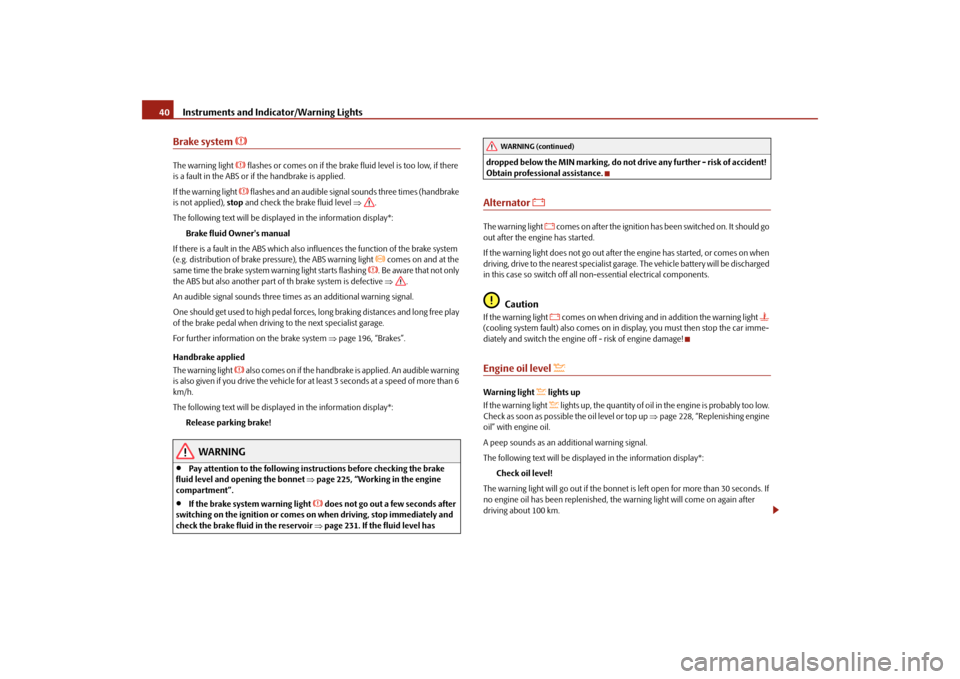
Instruments and Indicator/Warning Lights
40
Brake system
The warning light
flashes or comes on if the brake fluid level is too low, if there
is a fault in the ABS or if
the handbrake is applied.
If the warning light
flashes and an audible signal sounds three times (handbrake
is not applied),
stop
and check the brake fluid level
⇒
.
The following text will be displayed in the information display*:
Brake fluid Owner's manual
If there is a fault in the ABS which also in
fluences the function of the brake system
(e.g. distribution of brake pressure), the ABS warning light
comes on and at the
same time the brake system warning light starts flashing
. Be aware that not only
the ABS but also another part of th brake system is defective
⇒
.
An audible signal sounds three times as an additional warning signal.One should get used to high pedal forces, long braking distances and long free play of the brake pedal when driving to the next specialist garage. For further information on the brake system
⇒page 196, “Brakes”.
Handbrake applied The warning light
also comes on if the handbrake is applied. An audible warning
is also given if you drive the vehicle for at least 3 seconds at a speed of more than 6 km/h. The following text will be displayed in the information display*:
Release parking brake!
WARNING
•
Pay attention to the following instru
ctions before checking the brake
fluid level and opening the bonnet
⇒page 225, “Working in the engine
compartment”.•
If the brake system warning light
does not go out a few seconds after
switching on the ignition or comes on when driving, stop immediately and check the brake fluid in the reservoir
⇒page 231. If the fluid level has
dropped below the MIN marking, do not
drive any further - risk of accident!
Obtain professional assistance.Alternator
The warning light
comes on after the ignition has been switched on. It should go
out after the engine has started. If the warning light does not go out after
the engine has started, or comes on when
driving, drive to the nearest specialist garage. The vehicle battery will be discharged in this case so switch off all non-essential electrical components.
Caution
If the warning light
comes on when driving and in
addition the warning light
(cooling system fault) also comes on in display, you must then stop the car imme- diately and switch the engine off - risk of engine damage!Engine oil level
Warning light
lights up
If the warning light
lights up, the quantity of oil in the engine is probably too low.
Check as soon as possible the oil level or top up
⇒page 228, “Replenishing engine
oil” with engine oil. A peep sounds as an additional warning signal.The following text will be displayed in the information display*:
Check oil level!
The warning light will go out if the bonnet is
left open for more than 30 seconds. If
no engine oil has been replenished, the
warning light will come on again after
driving about 100 km.
WARNING (continued)
se0.1.book Page 40 Friday, April 10, 2009 3:19 PM
Page 42 of 304
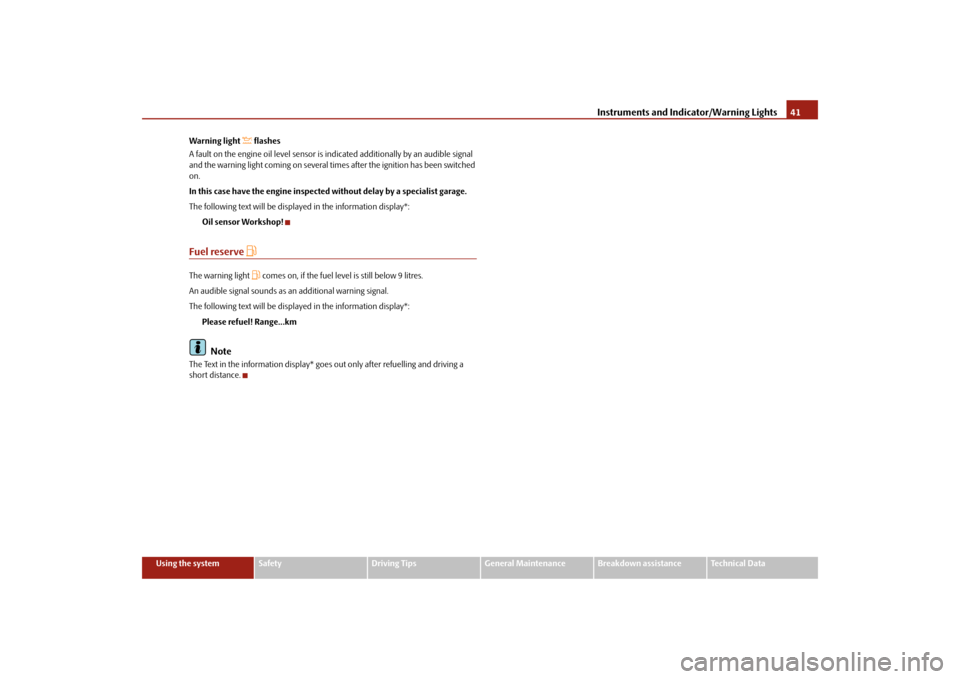
Instruments and Indicator/Warning Lights
41
Using the system
Safety
Driving Tips
General Maintenance
Breakdown assistance
Technical Data
Warning light
flashes
A fault on the engine oil level sensor is indicated additionally by an audible signal and the warning light coming on several times after the ignition has been switched on. In this case have the engine inspected without delay by a specialist garage.The following text will be displayed in the information display*:
Oil sensor Workshop!
Fuel reserve
The warning light
comes on, if the fuel level is still below 9 litres.
An audible signal sounds as an additional warning signal.The following text will be displayed in the information display*:
Please refuel! Range...kmNote
The Text in the information display* goes out only after refuelling and driving a short distance.
se0.1.book Page 41 Friday, April 10, 2009 3:19 PM
Page 45 of 304
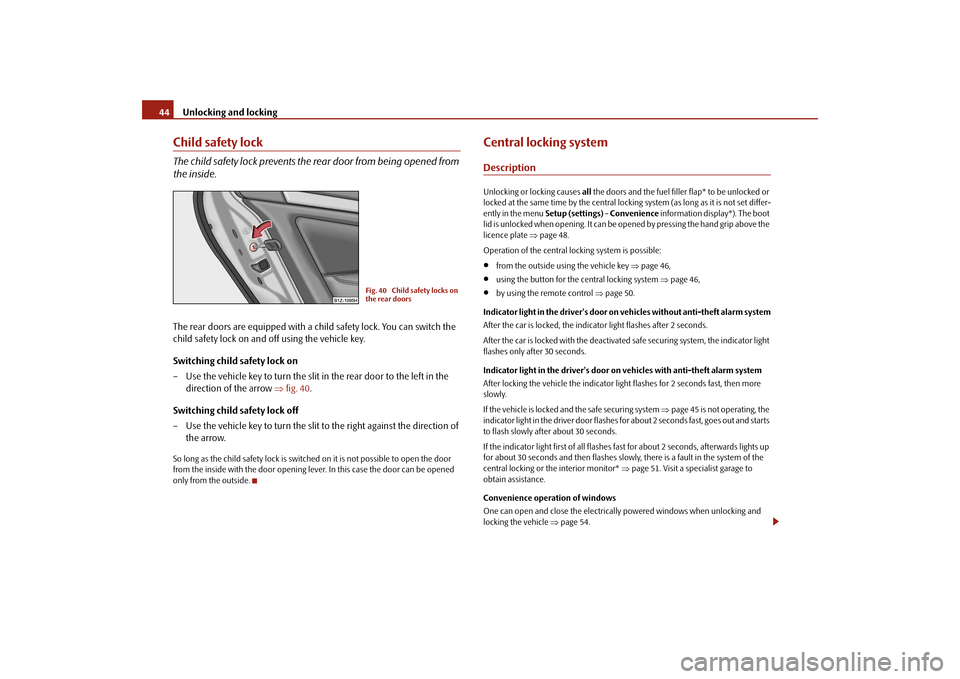
Unlocking and locking
44
Child safety lockThe child safety lock prevents the
rear door from being opened from
the inside.The rear doors are equipped with a child safety lock. You can switch the child safety lock on and off using the vehicle key. Switching child safety lock on – Use the vehicle key to turn the slit in the rear door to the left in the
direction of the arrow
⇒
fig. 40
.
Switching child safety lock off – Use the vehicle key to turn the slit to the right against the direction of
the arrow.
So long as the child safety lo
ck is switched on it is no
t possible to open the door
from the inside with the door opening lever. In this case the door can be opened only from the outside.
Central locking systemDescriptionUnlocking or locking causes
all the doors and the fuel filler flap* to be unlocked or
locked at the same time by the central lockin
g system (as long as it is not set differ-
ently in the menu
Setup (settings)
- Convenience
information display*). The boot
lid is unlocked when opening. It can be op
ened by pressing the hand grip above the
licence plate
⇒page 48.
Operation of the central locking system is possible:•
from the outside using the vehicle key
⇒page 46,
•
using the button for the central locking system
⇒page 46,
•
by using the remote control
⇒page 50.
Indicator light in the driver's door on vehicles without anti-theft alarm system After the car is locked, the indicator light flashes after 2 seconds. After the car is locked with the deactivate
d safe securing system, the indicator light
flashes only after 30 seconds. Indicator light in the driver's door on vehicles with anti-theft alarm system After locking the vehicle the indicator light flashes for 2 seconds fast, then more slowly. If the vehicle is locked and the safe securing system
⇒page 45 is not operating, the
indicator light in the driver door flashes fo
r about 2 seconds fast, goes out and starts
to flash slowly after about 30 seconds. If the indicator light first of all flashes fast for about 2 seconds, afterwards lights up for about 30 seconds and then flashes slowly
, there is a fault in the system of the
central locking or the interior monitor*
⇒page 51. Visit a specialist garage to
obtain assistance. Convenience operation of windows One can open and close the electrically
powered windows when unlocking and
locking the vehicle
⇒page 54.
Fig. 40 Child safety locks on the rear doors
se0.1.book Page 44 Friday, April 10, 2009 3:19 PM
Page 51 of 304
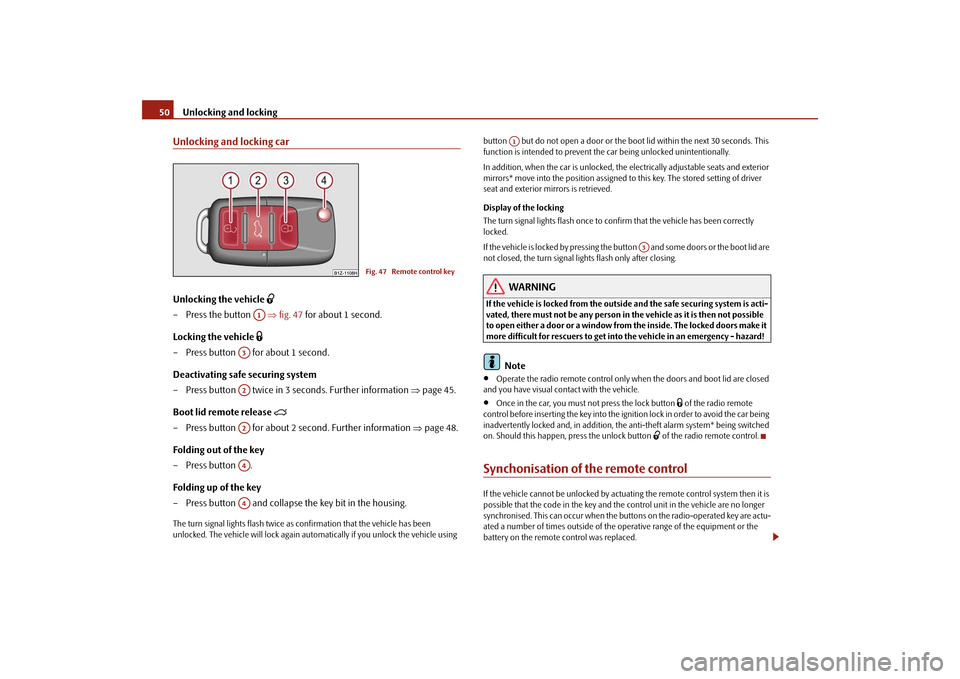
Unlocking and locking
50
Unlocking and locking carUnlocking the vehicle
– Press the button
⇒
fig. 47
for about 1 second.
Locking the vehicle
– Press button for about 1 second.Deactivating safe securing system – Press button twice in 3 seconds. Further information
⇒
page 45.
Boot lid remote release
– Press button for about 2 second. Further information
⇒
page 48.
Folding out of the key – Press button . Folding up of the key – Press button and collapse the key bit in the housing.The turn signal lights flash twice as
confirmation that the vehicle has been
unlocked. The vehicle will lock again auto
matically if you unlock the vehicle using
button but do not open a door or the b
oot lid within the next 30 seconds. This
function is intended to prevent the car being unlocked unintentionally. In addition, when the car is unlocked, the el
ectrically adjustable seats and exterior
mirrors* move into the position assigned to this key. The stored setting of driver seat and exterior mirrors is retrieved. Display of the locking The turn signal lights flash once to co
nfirm that the vehicle has been correctly
locked. If the vehicle is locked by
pressing the button and some doors or the boot lid are
not closed, the turn signal lights flash only after closing.
WARNING
If the vehicle is locked from the outsid
e and the safe securing system is acti-
vated, there must not be any person in the vehicle as it is then not possible to open either a door or a window from the inside. The locked doors make it more difficult for rescuers to get into
the vehicle in an emergency - hazard!
Note
•
Operate the radio remote control only when the doors and boot lid are closed
and you have visual co
ntact with the vehicle.
•
Once in the car, you must
not press the lock button
of the radio remote
control before inserting the key into the ignition lock in order to avoid the car being inadvertently locked and, in addition, the anti-theft alarm system* being switched on. Should this happen, press the unlock button
of the radio remote control.
Synchonisation of the remote controlIf the vehicle cannot be unlocked by actuatin
g the remote control system then it is
possible that the code in the key and the
control unit in the vehicle are no longer
synchronised. This can occur when the buttons on the radio-operated key are actu- ated a number of times outside of the operative range of the equipment or the battery on the remote control was replaced.
Fig. 47 Remote control key
A1
A3A2A2A4A4
A1
A3
se0.1.book Page 50 Friday, April 10, 2009 3:19 PM
Page 61 of 304

Lights and Visibility
60
If the vehicle speed is below 65 km/h for at least 2 minutes, the lights are switched off. Rain lights If you switch on the windscreen wipe in
the operation rain sensor* for longer than
10 seconds or in the operation pe
rmanent wipe (position 2 or 3)
⇒page 69
switching on for longer than 15 seconds, th
e side lights and low beam are switched
on automatically. The light switches off if
the windscreen wipe is in operation rain
sensor* for more than 4 minutes or is no
t switched on in the operation permanent
wipe.
WARNING
The automatic light control only operat
es as a support. The driver is not
released from his responsibility to inspect the light and if necessary to switch on the light depending on the light
conditions. The light sensor cannot
detect for example rain or snow. Fo
r these conditions we recommend to
switch on the low beam
!
Note
•
Do not affix any stickers in front of the light sensor, so that you do not impair its
function or put it out of operation.•
The same principles as for using the au
tomatic light control also apply to the
light which is switched on manually
⇒page 58.
Cornering lights*The cornering lights are used to illuminate the curves by means of the cone of light swiveling together with the front headlight with Xenon lights*. This function is active when the speed of the car increases to more than 10km/h. The swiveling function of the headlights ca
n be switched off / on via the menu point
Assistant
in the main menu of the Information display*
⇒page 26.
WARNING
If the cornering lights are defectiv
e, the headlights are automatically
lowered to the emergency position, wh
ich prevents a possible dazzling of
oncoming traffic. Thus the illuminated length of the road is shortened. Drive carefully and have the car inspected
immediately by a specialist garage.
Coming Home FunctionThe function makes it possible to switch on the lights in the darkness for a short time after leaving the vehicle. Switching on Coming Home Function – The light switch is in the positi
on automatic driving lamp control
and the low beam illuminates.
– Switch off the ignition. – After opening the driver's door, the function Coming Home is
switched on.
– Close all the doors and the boot lid and lock the vehicle. After a short
time, switch all lights off.
Depending on equipment fitted the func
tion Coming Home switches on the
following lights:•
Parking lights,
•
Low beam,
•
Entry lighting in the exterior mirrors,
•
Licence plate light.
Coming Home Function The lights go out 10 seconds after closing all the doors and the boot lid. If a door or the boot lid re
mains open, the lights go ou
t 60 seconds after switching
off the ignition.
se0.1.book Page 60 Friday, April 10, 2009 3:19 PM
Page 62 of 304

Lights and Visibility
61
Using the system
Safety
Driving Tips
General Maintenance
Breakdown assistance
Technical Data
The function Coming Home is controlled wi
th the light sensor in the mount of the
interior rear mirror. If the light intensity is higher than the set value of the light sensor, the Coming Home Function is not switched on after switching off the igni-tion.
Note
•
If the Coming Home Function is switch
ed on constantly, the battery will be
heavily discharged particular
ly in short-haul traffic.
•
The switching on of the described lights
should only be undertaken in accord-
ance with the legal requirements.•
You can change the illumination period
for the Coming Home Function by
means of the information display*.Leaving Home FunctionThis function makes it possible to switch on the lights when approaching the vehicle. Switching on Leaving Home Function – Unlock the vehicle with the radio remote control - the lights come on.Depending on equipment fitted the function Leaving Home switches on the following lights:•
Parking lights,
•
Low beam,
•
Entry lighting in the exterior mirrors,
•
Licence plate light.
Leaving Home Function The function Leaving Home is controlled wi
th the light sensor in the mount of the
interior rear mirror. If the light intensity is higher than the set value of the light sensor, the Leaving Home Function is not
switched on after unlocking the vehicle
with the radio remote control.
After unlocking the vehicle with the radio re
mote control, the lights come on for 10
seconds. The Leaving Home Function is also switched off after the ignition is switched on and after locking the vehicle. If no door is opened within 30 seconds,
the lights go out and the vehicle is locked
automatically.
Note
•
If the Leaving Home Function is switch
ed on constantly, the battery will be
heavily discharged particular
ly in short-haul traffic.
•
The switching on of the described lights
should only be und
ertaken in accord-
ance with the legal requirements.•
You can change the illumination period
for the Leaving Home Function by
means of the information display*.To u r i s t l i g h t *This mode makes it possible to drive in
countries with opposing traffic system,
driving on the left/right, without dazzling the oncoming vehicles. When the mode “tourist light” is active, the side to side swivel of the headlights is deactivated. The mode “tourist light” is activated / deac
tivated via the information display* in the
menu:�„
SETUP (Settings)
�„
Tra v e l m o d e�„
Off
�„
On
se0.1.book Page 61 Friday, April 10, 2009 3:19 PM
Page 64 of 304

Lights and Visibility
63
Using the system
Safety
Driving Tips
General Maintenance
Breakdown assistance
Technical Data
Instrument lighting*
You can adjust the brightness of the instrument lighting.Instrument lighting – Switch on the light. – Turn the control dial
⇒
fig. 57
to the desired intensity of the instru-
ment lighting.
For the information display*
⇒page 26 the intensity of the lighting is automatically
set. It is only possible to adjust the inst
rument lighting with the control dial if the
light intensity drops below the set value of the light sensor.
Headlamp range adjustment
Once the low beam is switched on
you can then adapt the range of
the headlights to the
load of the vehicle.
– Turn the control dial
⇒
fig. 58
until you have adjusted the low beam
so that oncoming traffic is not dazzled.
Settings The positions correspond approximat
ely to the following vehicle loads:
Front seats occupied, luggage compartment empty. All seats occupied, lugga
ge compartment empty.
All seats occupied, luggage compartment laden.Driver seat occupied, lu
ggage compartment laden.
Caution
Set the headlight beam adjustment in su
ch a way as to avoid dazzling oncoming
traffic.
Note
Headlights fitted with Xenon bulbs* adap
t automatically to the load and driving
state of the vehicle (e.g. accelerating, braking) when the ignition is switched on and
Fig. 57 Dash panel: Instru- ment lighting
Fig. 58 Dash panel: Lights and Visibility
A-A1A2A3
se0.1.book Page 63 Friday, April 10, 2009 3:19 PM
Page 65 of 304

Lights and Visibility
64
when driving. Vehicles which are equipp
ed with Xenon bulbs* do not have a
manual headlight range adjustment control.Switch for hazard warning lights
– Press switch
⇒
fig. 59
to switch the hazard warning light system on
or off.
All the turn signal lights on the vehicle
flash at the same time when the hazard
warning light system is switched on. The in
dicator light for the turn signals and the
indicator light in the switch also flash at
the same time. You can also switch on the
hazard warning light system if the ignition is switched off. The hazard warning light system is swit
ched on automatically if an airbag is
deployed in the event of an accident. Please comply with any legal requirements when using the hazard warning light system.
Note
Switch on the hazard warning light system if, for example:•
you encounter traffic congestion,
•
your vehicle breaks down or an emergency situation occurs.
The turn signal
and main beam lever
The parking lights and headlight flasher are also switched on and off using the turn signal and main beam lever.The turn signal and main beam lever perform the following functions: Right
and left
turn signal light
– Push the lever upwards or downwards
⇒
fig. 60
.
– If you only wish to flash three time
s* (the so-called convenience turn
signal), push the lever briefly up to
the upper or lower pressure point
and release it. This function can be activated/deactivated in the infor-mation display*
⇒
page 26.
– Turn signal for changing lanes - in order to only flash briefly, move the
lever up or down to the pressure point and hold it in this position.
Main beam
– Switch on the low beam. – Push the lever forwards.– Pull the lever back into the initial po
sition in order to switch the main
beam off again.
Fig. 59 Dash panel: Switch for hazard warning lights
Fig. 60 Turn signal and main beam lever
se0.1.book Page 64 Friday, April 10, 2009 3:19 PM
Page 117 of 304
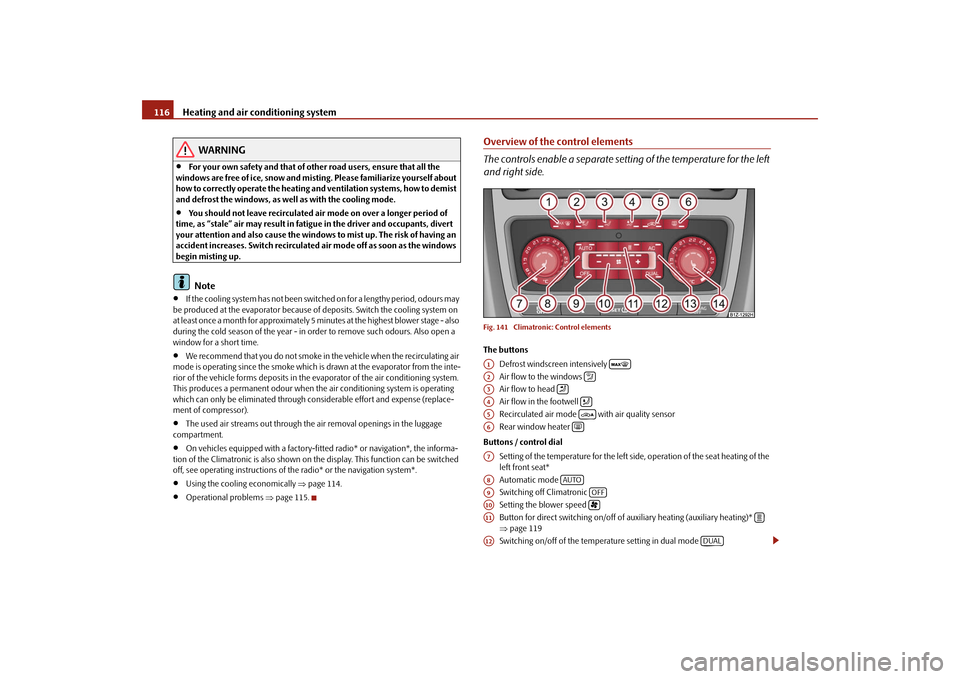
Heating and air conditioning system
116
WARNING
•
For your own safety and that of other road users, ensure that all the
windows are free of ice, snow and mistin
g. Please familiarize yourself about
how to correctly operate th
e heating and ventilation systems, how to demist
and defrost the windows, as well as with the cooling mode.•
You should not leave recirculated air mode on over a longer period of
time, as “stale” air may result in fatigue in the driver and occupants, divert your attention and also cause the windows to mist up. The risk of having an accident increases. Switch recirculated air mode off as soon as the windows begin misting up.
Note
•
If the cooling system has not been switched on for a lengthy period, odours may
be produced at the evaporator because of
deposits. Switch the cooling system on
at least once a month for approximately 5 mi
nutes at the highest blower stage - also
during the cold season of the year - in order to remove such odours. Also open a window for a short time.•
We recommend that you do not smoke in the vehicle when the recirculating air
mode is operating since the smoke which is drawn at the evaporator from the inte-rior of the vehicle forms deposits in the
evaporator of the air
conditioning system.
This produces a permanent odour when the air conditioning system is operating which can only be eliminated through considerable effort and expense (replace-ment of compressor).•
The used air streams out through the air removal openings in the luggage
compartment.•
On vehicles equipped with a factory-fitted radio* or navigation*, the informa-
tion of the Climatronic is also shown on th
e display. This function can be switched
off, see operating instructions of th
e radio* or the navigation system*.
•
Using the cooling economically
⇒page 114.
•
Operational problems
⇒page 115.
Overview of the control elements The controls enable a separate setting of the temperature for the left and right side.Fig. 141 Climatronic: Control elementsThe buttons
Defrost windscreen intensively Air flow to the windows Air flow to head Air flow in the footwell Recirculated air mode with air quality sensor Rear window heater
Buttons / control dial
Setting of the temperature for the left side, operation of the seat heating of the left front seat* Automatic mode Switching off Climatronic Setting the blower speed Button for direct switching on/off of auxiliary heating (auxiliary heating)* ⇒ page 119 Switching on/off of the temperature setting in dual mode
A1
A2
A3
A4
A5
A6
A7A8
AUTO
A9
OFF
A10
A11
A12
DUAL
se0.1.book Page 116 Frida
y, April 10, 2009 3:19 PM